Princeton Geniza Project Releases New Public Site
12 April 2022
4.3.1 versions for 1000+ years: the oldest-living geniza database tells all!
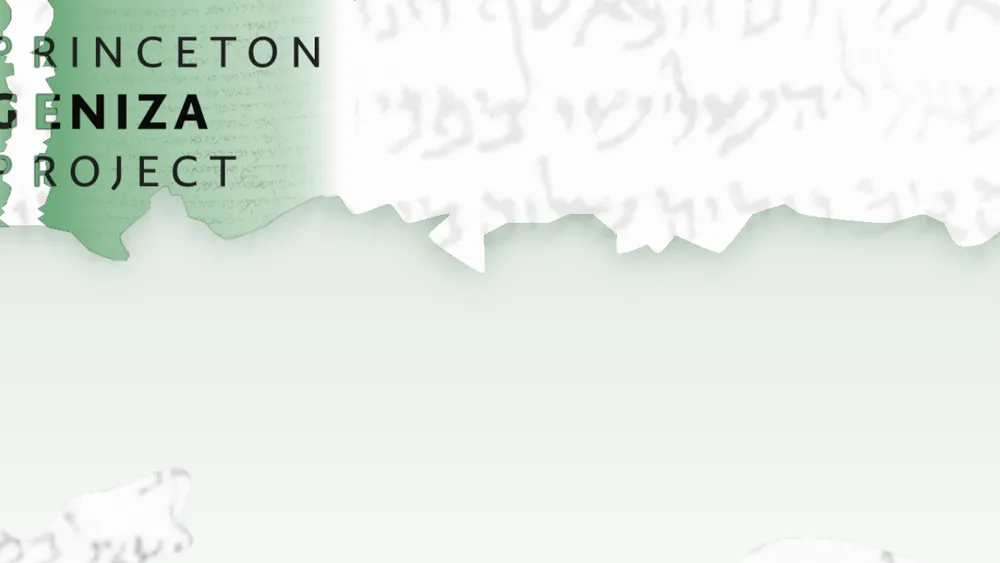
“Angry letters from a wife to her absent husband. Complaints about business travel. Memo about an opium deal. Accounts of a silk merchant. Graphic descriptions of gastrointestinal problems. Complaints about bedbugs.”
These are just a few of the the topics you can search directly from the homepage of version 4.0 of the Princeton Geniza Project (PGP), released earlier this semester. (Because the team is moving at warp speed, the current version is 4.3.1—and it’s only April!)
The redesigned site, created through a research partnership between the PGP and the Center for Digital Humanities, offers users access to tens of thousands of the documents found in the geniza chamber of Ben Ezra Synagogue in Cairo and now housed in libraries across the world.
The documents, written in Judaeo-Arabic, Hebrew, Aramaic, and Arabic, mostly date to the Middle Ages. Comprising everything from personal letters to legal documents, the geniza documents are a critical resource for scholars working on the medieval Middle East, Jewish studies, and the history of the Mediterranean and Indian Ocean basins.
The PGP site provides transcriptions and/or translations of selected documents and images of many fragments (note: in this context, a fragment is a physical piece of a manuscript; a document can thus be divided into multiple fragments that are now held by different libraries). Side-by-side images and transcriptions—a unique feature among geniza sites—aid researchers in decoding the characters.
For documents that have been cited in academic writing, “scholarship records” lead researchers to a selection of published and unpublished resources related to the documents in question.
Users can also search the site for documents of interest. Tags, which work similarly to hashtags on social media, categorize documents by theme. Users can click all the “tags” on the documents to view a list of documents with the same tag.
For instance, the account of the silk merchant mentioned on the homepage is tagged #account, #silk, and #trade, allowing researchers to locate documents with similar topics with a single click.
What’s exciting about the new version(s) of the site?
For one thing: design! Version 4.0, among other new features, includes different colors for light (green/white) and dark (pink/black) modes, as well as updated versions of fonts with extended character support.
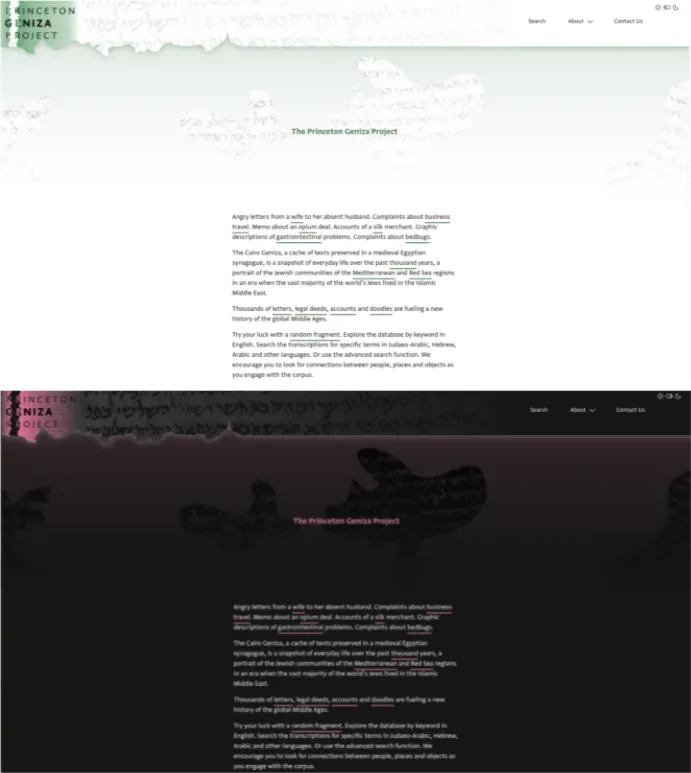
The PGP homepage in light mode (above) and dark mode (below).
Moreover, enhanced search capabilities promise to help researchers both to work more efficiently and to identify even more new resources relevant to their interests.
Beginning with version 4.2, users who search by keywords can filter their results so that they only see documents with transcriptions and/or translations available, or that have scholarly commentary (“discussions”) attached.
Users also have the option to sort results randomly (rather than by relevance) so that they can discover resources they haven’t seen before.
In addition, the PGP team has worked to make the scholarship records more useful to researchers. In previous versions of the site, some scholarship records were tracked in a different system, and thus hard for the team to manage and update. Now, users can see at a glance whether a document has scholarship records in the system and, if it does, how many there are; and the project team can add and update those records through one administrative interface. (Read about the structure of the new database, which made this possible.)
Users of the site will also notice the new mobile-friendly interface and thumbnail images in the search.
Not all changes are visible to the public, however. For those working behind the scenes, easy navigation between the public site and the administrative interface allows PGP team members hoping to edit records to open the edit window with just a single click. (Scroll down to read—and see!—what the PGP team said they enjoy most about the new versions!)
Want to see more details about PGP 4.0—beyond? Check out the change log on Github.
You can also follow the change log—and keep an eye on this blog—to learn about new features as they are released. Currently in the works: a new-and-improved system for adding and editing transcriptions and preliminary work on document dates.
What’s more, the PGP team is working with the Center for Statistics and Machine Learning to explore search alternatives that foreground the relationship between search results rather than simply listing them, an idea developed by User Experience Designer Gissoo Doroudian (read more about Gissoo’s search idea, Bona Fide).
And, as always, make sure to follow the Princeton Geniza Lab (@GenizaLab) for the latest!
At a Zoom meeting earlier this semester, the PGP team reflected on their favorite parts of the new site. Quotations have been streamlined and edited for clarity.
Rachel Richman (project manager): It’s exciting to see the images in line and to see them on all the document detail page. The way it all works together is absolutely thrilling. It began helping me on my research the day it was released.
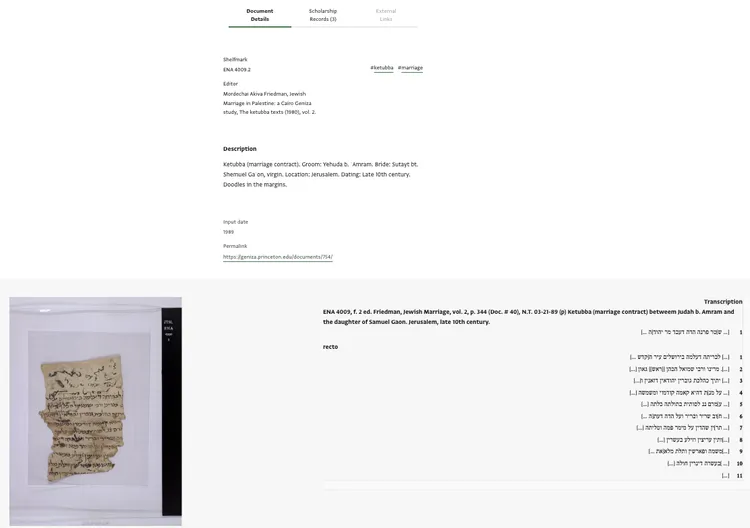
This document detail page for a marriage contract features an image of the fragment with side-by-side transcription.
Marina Rustow (co-PI): I love the design. I spent an inordinate amount of time this weekend toggling between light and dark mode. The scholarship records fulfill a vision I started developing in 2015, when I realized the PGP could be a tool for capturing as many of the interim products of scholarly research on the documentary geniza as possible. It’s really challenging material. Any interaction between a geniza fragment and a human brain with the training to understand it is worth knowing about. The PGP site is now the physical embodiment of this idea.
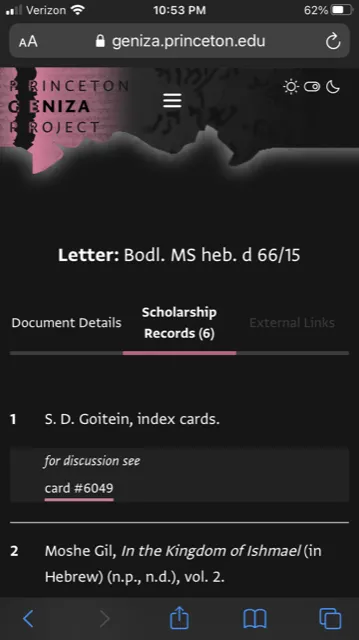
A screenshot of the mobile site in dark mode shows the first two scholarship records associated with a letter sent from Alexandria to Fustat.
Ben Silverman (software developer, Performant Software): I really like the search fields design. It just makes you want to interact with the site. Searches for large databases don't always make you want to click and type. This does.
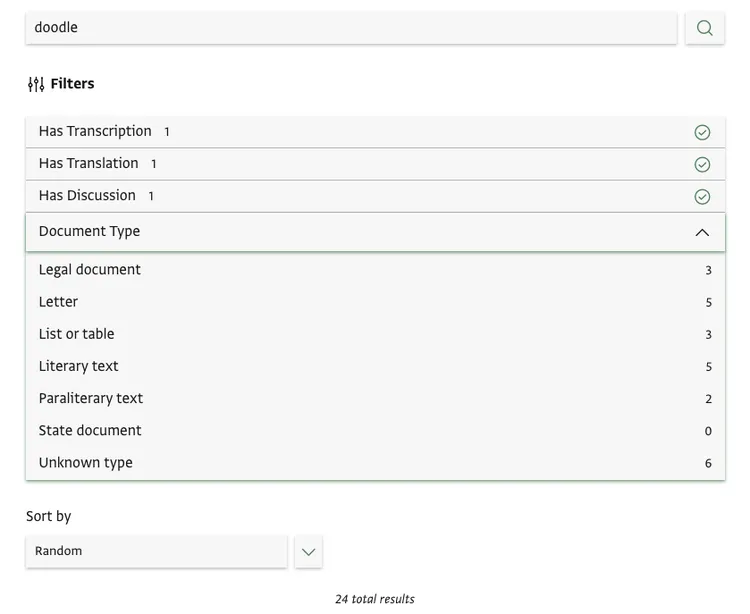
How many ways can you search for “doodle”?
Gissoo Doroudian (UX Designer): I like the search results page a lot. I like the fact that there is a lot of metadata for each result—the number of transcriptions or translations or discussions for each document.
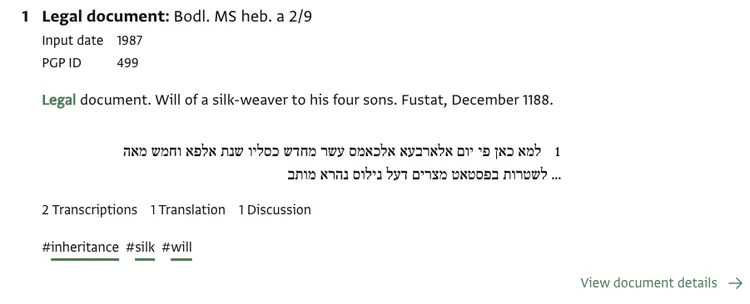
The site includes two transcriptions, one translation, and one discussion of this twelfth-century will.
Rebecca Koeser (co-PI): The first thing that came to mind for me was the images in the search results. And I love playing with the search, particularly the keywords in context and seeing the results.
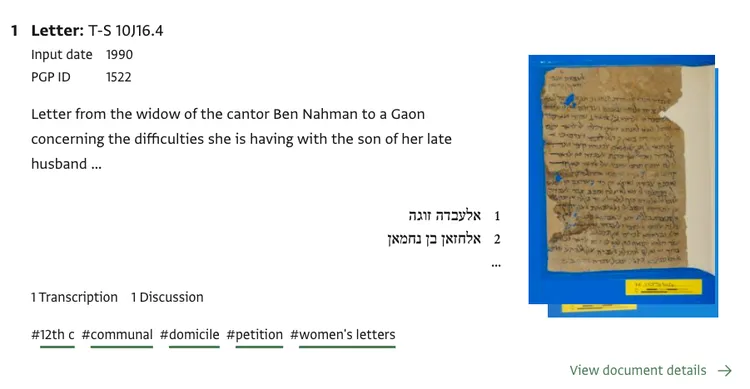
A randomly sorted keyword search for “letter” produced this document detailing the writer’s struggles with her step-children.
Zohar Berman (assistant project manager): I really love the way that Gissoo has an eye for design that incorporates the scribes themselves. The small details are really important. They give character to the site. I appreciate the product, but I appreciate it even more because I know the people who are behind it and everyone who has gotten us to this point.

Zohar and other members of the PGP team provided Gissoo with archival materials that helped inspire the design. The header, shown above, evokes a fragment.
Jessica Parker (project manager, Princeton Geniza Lab): I like the text of the homepage. I find it inviting.
Try your luck with a random fragment. Explore the database by keyword in English. Search the transcriptions for specific terms in Judaeo-Arabic, Hebrew, Arabic and other languages. Or use the advanced search function. We encourage you to look for connections between people, places and objects as you engage with the corpus.
This is just a “fragment” of the homepage text — head to the Princeton Geniza Project to read more!
Thank you to Marina Rustow, Rebecca Koeser, and Rachel Richman for comments on this blog post.